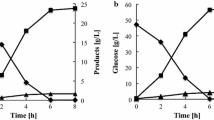Abstract
Ethanol production using hemicelluloses has recently become a focus of many researchers. In order to promote d-xylose fermentation, we cloned the bacterial xylA gene encoding for xylose isomerase with 434 amino acid residues from Agrobacterium tumefaciens, and successfully expressed it in Saccharomyces cerevisiae, a non-xylose assimilating yeast. The recombinant strain S. cerevisiae W303-1A/pAGROXI successfully colonized a minimal medium containing d-xylose as a sole carbon source and was capable of growth in minimal medium containing 2% xylose via aerobic shake cultivation. Although the recombinant strain assimilates d-xylose, its ethanol productivity is quite low during fermentation with d-xylose alone. In order to ascertain the key enzyme in ethanol production from d-xylose, we checked the expression levels of the gene clusters involved in the xylose assimilating pathway. Among the genes classified into four groups by their expression patterns, the mRNA level of pyruvate decarboxylase (PDC1) was reduced dramatically in xylose media. This reduced expression of PDC1, an enzyme which converts pyruvate to acetaldehyde, may cause low ethanol productivity in xylose medium. Thus, the enhancement of PDC1 gene expression may provide us with a useful tool for the fermentation of ethanol from hemicellulose.





Similar content being viewed by others
References
Chandrakant P, Bisaria VS (1998) Simultaneous bioconversion of cellulose and hemicellulose to ethanol. Crit Rev Biotechnol 18:295–331
Jeffries TW (2006) Engineering yeast for xylose metabolism. Curr Opin Biotechnol 17:320–326
Tanino T, Hotta A, Ito T, Ishii J, Yamada R, Hasunuma T, Ogino C, Ohmura N, Ohshima T, Kondo A (2010) Construction of a xylose-metabolizing yeast by genome integration of xylose isomerase gene and investigation of the effect of xylitol on fermentation. Appl Microbiol Biotechnol 88:1215–1221
Almeida JR, Runquist D, Sànchez Nogué V, Lidén G, Gorwa-Grauslund MF (2011) Stress-related challenges in pentose fermentation to ethanol by the yeast Saccharomyces cerevisiae. Biotechnol J 6(3):286–299. doi:10.1002/biot.201000301
Richard P, Toivari MH, Penttila M (2000) The role of xylulokinase in Saccharomyces cerevisiae xylulose catabolism. FEMS Microbiol Lett 190:39–43
Kang HA, Hershey JWB (1994) Effect of initiation factor eIF-5A depletion on protein synthesis and proliferation of Saccharomyces cerevisiae. J Bio Chem 269:3934–3940
Sambrook J, Russell DW (1989) Molecular cloning: a laboratory manual. Cold Spring Harbor, NY
Park JN, Lee KH, Ko HM, Seo KH, Chin JE, Lee HB, Bai S (2004) Expression of ethionine resistance conferring gene in an industrial strains of Saccharomyces cerevisiae. Kor J Microbiol Biotechnol 32:356–361
Gietz RD, Schiest RH (2007) Large-scale high efficiency yeast transformation using the LiAc/ss carrier DNA/PEG method. Nat Protocols 2:38–41
Laemmli UK (1970) Cleavage of structural proteins during the assembly of the head of bacteriophage T4. Nature 227:680–685
Dische Z, Borenfreund E (1951) A new spectrophotometric method for the deletion and determination of keto sugars and triose. J Biol Chem 192:583–587
Ma Y, Lin LL, Chien HR, Hsu WH (2000) Efficient utilization of starch by a recombinant strain of Saccharomyces cerevisiae producing glucoamylase and isoamylase. Biotechnol Appl Biochem 31:55–59
Phillips AJ (2006) Homology assessment and molecular sequence alignment. J Biomed Inform 39:18–33
van Maris AJ, Winkler AA, Kuyper M, de Laat WT, van Dijken JP, Pronk JT (2007) Development of efficient xylose fermentation in Saccharomyces cerevisiae: xylose isomerase as a key component. Adv Biochem Eng Biotechnol 108:179–204
Ko BS, Kim DM, Yoon BH, Bai S, Lee HY, Kim JH, Kim IC (2011) Enhancement of xylitol production by attenuation of intracellular xylitol dehydrogenase activity in Candida tropicalis. Biotechnol Lett 33:1209–1213
Otterstedt K, Larsson C, Bill RM, Stahlberg A, Boles E, Hohmann S, Gustafsson L (2004) Switching the mode of metabolism in the yeast Saccharomyces cerevisiae. EMBO reports 5:532–537
Ishchuk OP, Voronovsky AY, Stasyk OV, Gayda GZ, Gonchar MV, Abbas CA, Sibirny AA (2008) Overexpression of pyruvate decarboxylase in the yeast Hansenula polymorpha results in increased ethanol yield in high-temperature fermentation of xylose. FEMS Yeast Res 8:1164–1174
Acknowledgments
This study was financially supported by Chonnam National University, 2006.
Author information
Authors and Affiliations
Corresponding authors
Rights and permissions
About this article
Cite this article
Kim, D.M., Choi, SH., Ko, B.S. et al. Reduction of PDC1 expression in S. cerevisiae with xylose isomerase on xylose medium. Bioprocess Biosyst Eng 35, 183–189 (2012). https://doi.org/10.1007/s00449-011-0638-4
Received:
Accepted:
Published:
Issue Date:
DOI: https://doi.org/10.1007/s00449-011-0638-4




